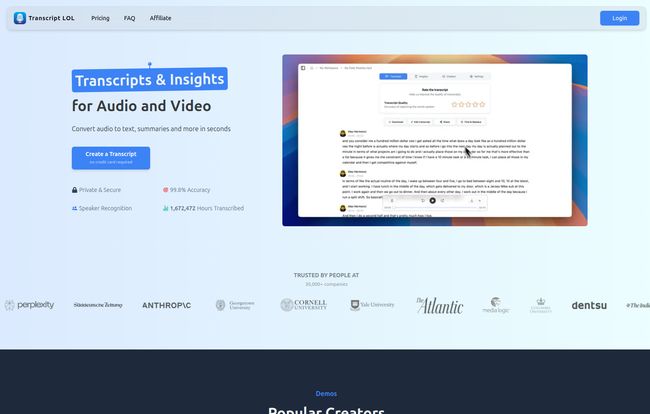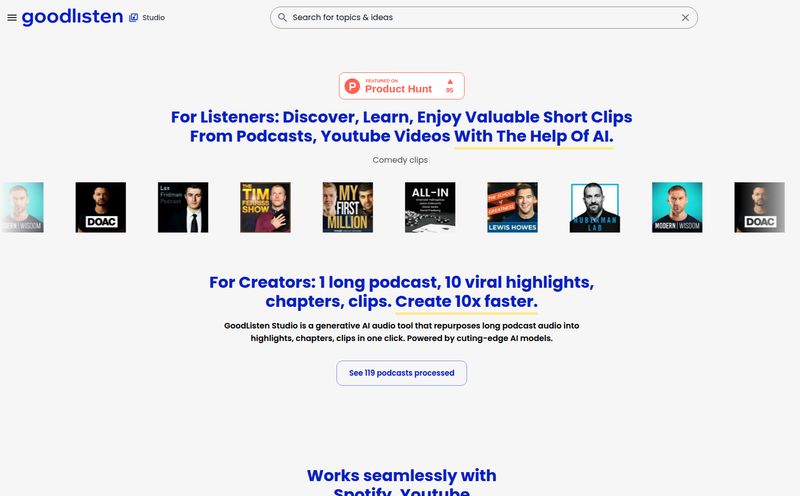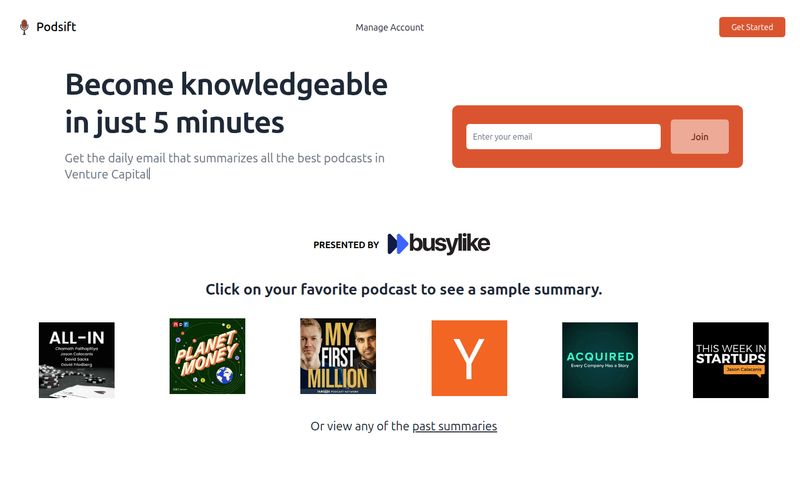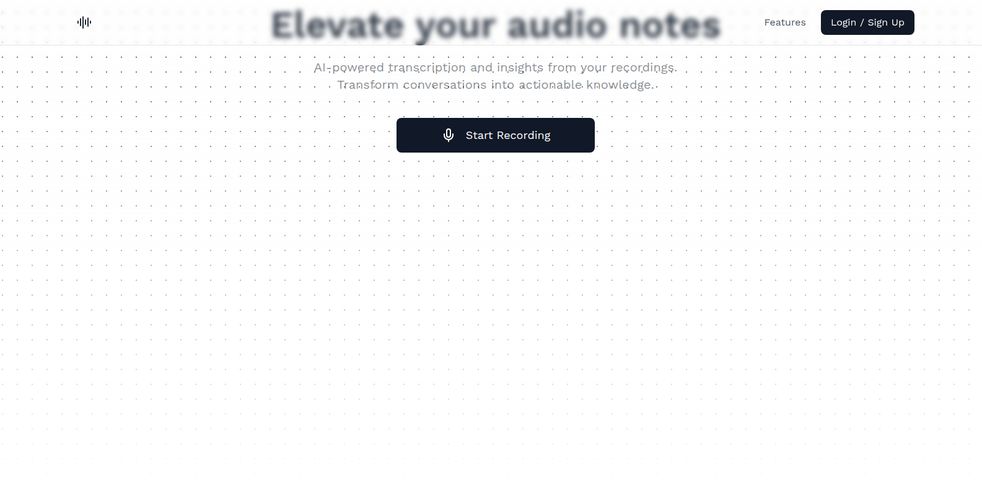If you work with any kind of audio or video content, you know the soul-crushing pain of transcription. It's the digital equivalent of washing dishes after a huge party. Necessary, but ugh. You either spend hours doing it yourself, wearing out the pause button on your keyboard, or you pay a small fortune for a human service with a week-long turnaround.
For years, I've been bouncing between different AI transcription tools, always on the hunt for the one that gets it right without requiring a second mortgage. So when I stumbled upon a tool with a name as cheeky as Transcript LOL, I was intrigued. The name itself felt like a bit of an inside joke for anyone who's ever laughed (or cried) at a horribly botched automated transcript. But could it live up to the hype? I decided to put it through its paces.
So, What is Transcript LOL, Really?
At its core, Transcript LOL does what it says on the tin: it turns your audio and video files into text. But that’s like saying a smartphone just makes calls. The real magic is in the how and the what else. This isn’t just a simple speech-to-text engine. It's an AI-powered platform designed to pull meaningful insights out of your raw content, fast.
Think about all those podcasts from creators like Joe Rogan or Andrew Huberman. This tool is built for that exact kind of content. It's aimed squarely at podcasters, marketers, journalists, students, and researchers—basically, anyone who has a mountain of recorded material and not enough time. It promises not just a transcript, but summaries, key topics, and more, all in a matter of minutes, not hours.

Visit Transcript LOL
The Features That Actually Matter
Any tool can list a dozen features on its homepage, but which ones actually save you time and headaches? After playing around with it, a few things really stood out.
Speed and Accuracy: The Non-Negotiables
Let's start with the absolute basics. If a transcription service is slow or inaccurate, nothing else matters. Transcript LOL claims 99%+ accuracy, which is a bold claim in this space. In my test with a fairly clear, two-person podcast episode, the results were… frankly, stunning. It handled industry jargon surprisingly well and made very few errors. It’s not perfect—no AI is—but the amount of clean-up I had to do was minimal. We're talking minutes of proofreading, not hours of re-typing.
And the speed? It’s fast. Like, go-make-a-coffee-and-it's-done fast. For a 45-minute audio file, I had a full transcript in under five minutes. It’s like having a hyper-caffeinated stenographer on call 24/7, ready to go the second you are.
Speaker Recognition: Finally, No More 'Speaker 1'
This is a big one for me. There is nothing more tedious than going through a transcript of an interview and having to manually label who said what. Transcript LOL nails this. It automatically detects and separates different speakers, labeling them clearly throughout the document. For anyone producing interview-based content, this feature alone is worth its weight in gold. It turns a messy wall of text into a clean, readable script, ready for editing or pulling quotes.
AI Insights: This is More Than Just Words
Here’s where Transcript LOL starts to pull away from the pack. It doesn't just give you the words; it helps you understand them. Once your transcript is ready, its AI gets to work generating a concise summary, identifying the main topics discussed, and even pulling out potential key takeaways.
This is a game-changer for content repurposing. That one-hour webinar can instantly become:
- A summary for your newsletter
- A list of key topics for a blog post outline
- A handful of powerful quotes for social media
- Actionable show notes for your podcast listeners
It stops being a static record and becomes a dynamic source of new content. This is where you see teh shift from a simple utility to a genuine productivity tool.
Let's Talk Money: The Transcript LOL Pricing
Ah, the all-important question. How much does it cost? I've seen some older, confusing pricing models for this tool floating around the web, but their current structure is refreshingly simple and, in my opinion, very aggressive.
| Plan | Price | Best For |
|---|---|---|
| Unlimited | $10 / month | Individuals, content creators, students. |
| Team | $20 / month / user | Agencies, businesses, and collaborative teams. |
The $10/month Unlimited plan for individuals is, frankly, a steal. You get unlimited transcripts, AI summaries, and priority processing. Many competitors charge per minute or have much lower monthly caps, which can get expensive fast. If you transcribe even two or three hours of audio a month, this plan pays for itself immediately.
The Team plan adds collaborative features like shared workspaces and centralized billing, which makes sense for agencies or businesses managing multiple projects.
Who Is This For, and Who Should Skip It?
So, is this the perfect tool for everyone? Not quite. Here’s my breakdown.
This is a fantastic fit for:
- Podcasters & YouTubers: Creating show notes, descriptions, blog posts, and social clips from your episodes becomes almost effortless.
- Students & Researchers: Transcribing lectures and interviews for study or analysis is a massive time-saver.
- Marketers & Journalists: Quickly pull quotes from interviews, webinars, and press briefings. Turn one piece of video content into ten written assets.
You might want to look elsewhere if:
- You need 100% perfect, court-ready transcripts: For legal or medical work where every single word must be perfect, you'll still need a human transcriptionist to do a final pass. AI is 99%+ accurate, not 100%.
- You only transcribe one 5-minute file a year: The monthly subscription model, while cheap, might not be worth it for extremely infrequent users.
The Good, The Bad, and The... Private
Let’s wrap this up with a quick summary. The good is obvious: incredible speed, high accuracy, fantastic speaker detection, and those genuinely useful AI summaries. All for a price that seriously undercuts a lot of the competition.
The bad? There's no obvious free-forever tier. For a solo creator, the $10 plan is a no-brainer, but if you're on a larger team, the $20-per-user cost for the Team plan could add up. I also wish the individual file size limit was a tad higher than 10 hours/3GB, but that’s a pretty niche complaint.
But here's the most interesting part, something I found tucked away in their FAQ: a strict no-training policy. "Your content is secure and private. We never use your data to train AI models." In an age where everyone is (rightfully) worried about how AI companies are using their data, this is a massive plus. It's a commitment to privacy that builds a lot of trust.
Frequently Asked Questions
Is Transcript LOL really unlimited?
Yes! For the individual plan, there are no caps on the number of files or hours you transcribe per month. As they say on their site, their only limit is the user's fair use of their own time.
Will my content be used to train your AI?
Nope. They have a strict policy against it. Your data is your data and is not used for any AI training purposes, which is a huge privacy win.
What kind of audio and video formats do you support?
A whole bunch. The list includes MP3, MP4, M4A, MOV, AAC, WAV, OGG, OPUS, MPEG, WMA, WMV, AVI, FLAC, and more. If you have an audio or video file, chances are it can handle it.
Is there a free trial?
There isn’t a traditional free trial period advertised. The model is a low-cost monthly subscription that you can cancel anytime, so the barrier to entry is pretty low to just try it for a month.
How does Transcript LOL compare to tools like Otter.ai?
While they operate in a similar space, Transcript LOL's main differentiators appear to be its simple, truly unlimited pricing model for individuals and its strict no-training data privacy policy. Many users also praise its clean interface and the quality of its AI summaries.
The Final Verdict: Is It a Buy?
After spending some quality time with Transcript LOL, I can confidently say it’s earned a permanent spot in my creator toolkit. It’s fast, it’s accurate, and it's priced so competitively that it's hard to argue with the value.
It successfully bridges the gap between being a simple utility and a smart assistant, turning the chore of transcription into an opportunity for content creation. For any individual creator drowning in audio or video files, the $10 monthly plan isn’t just a good deal; it’s one of the best productivity investments you can make. It just works.



